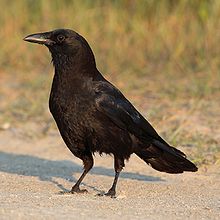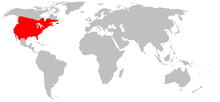American crow
| American crow | |
|---|---|
 |
|
| Scientific classification | |
| Kingdom: | Animalia |
| Phylum: | Chordata |
| Class: | Aves |
| Subclass: | Neornithes |
| Infraclass: | Neognathae |
| Superorder: | Neoaves |
| Order: | Passeriformes |
| Suborder: | Passeri |
| Superfamily: | Corvoidea |
| Family: | Corvidae |
| Genus: | Corvus |
| Species: | C. brachyrhynchos |
| Binomial name | |
|
Corvus brachyrhynchos Brehm, 1822 |
|
 |
|
| Global range | |
The American crow (Corvus brachyrhynchos) is a large passerine bird species of the family Corvidae. It is a common bird found throughout much of North America. American crows are the new world counterpart to the carrion crow and the hooded crow. Although the American crow and the hooded crow are very similar in size, structure and behavior, their calls are different. The American crow nevertheless occupies the same role the hooded crow does in Eurasia.
From beak to tail, an American crows measures 40–50 cm (16–20 in), almost half of which is tail. Mass varies from about 300 to 600 g (10 to 20 oz). Males tend to be larger than females. The most usual call is CaaW!-CaaW!-CaaW!.
The American crow is all black, with iridescent feathers. It looks much like other all-black corvids. They can be distinguished from the common raven (C. corax) because American crows are smaller and from the fish crow (C. ossifragus) because American crows do not hunch and fluff their throat feathers when they call.
American crows are common, widespread, and susceptible to the West Nile virus, making them useful as a bioindicator to track the virus's spread. Direct transmission of the virus from American crows to humans is unheard of and unlikely.
The American crow was described by Christian Ludwig Brehm in 1822. Its scientific name means literally "short-billed crow", from Ancient Greek brachy- (βραχυ-) "short-" and rhynchos (ρυνχος) "billed".
The northwestern crow (C. caurinus) is very closely related to the American crow. Its ancestors became separated by Ice Age glaciation west of the Rocky Mountains. It is endemic to Pacific temperate rain forests where it all but replaces the American crow. Only in the Seattle region do they co-occur to any extent. In form the two species are much alike. There is a marked difference in voice.
...
Wikipedia

